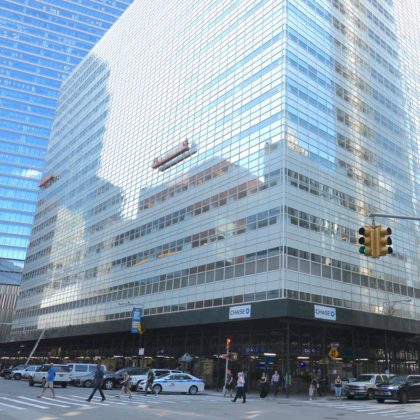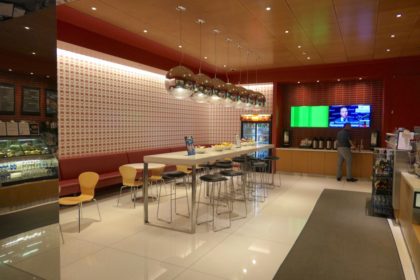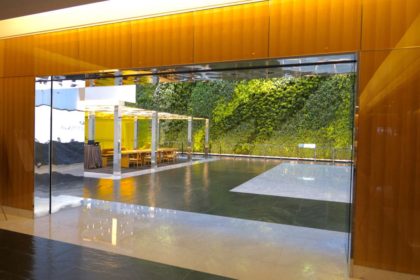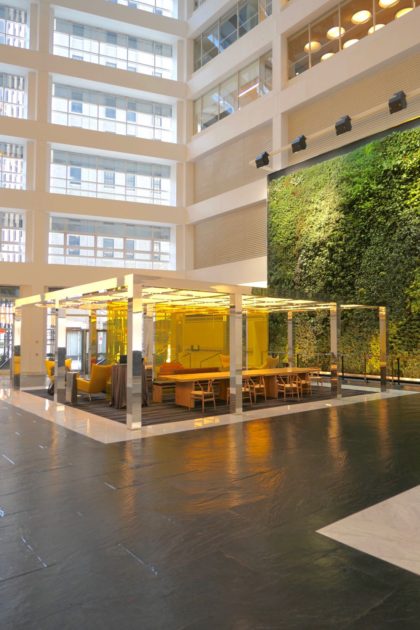Categories
Left column house ads
BNY Mellon’s Lobby Is Finally Open to the Public
September 4, 2018 Real Estate
 The city often allows developers to build larger than zoning allows in exchange for what’s called a privately owned public space, or POPS. In April of 2017, however, New York City comptroller Scott Stringer released an audit showing that many POPS don’t deliver what is required of them. A main case in point was the BNY Mellon headquarters at 101 Barclay/240 Greenwich; since 9/11, without ever running the change by city officials, the public was barred, and signs on the doors claimed only employees were allowed to enter. (The guards got shirty if you tried.) Last April, the Department of Buildings, which is responsible for POPS compliance, told Community Board 1 that it was actually going to conduct annual inspections, starting in 2019.
The city often allows developers to build larger than zoning allows in exchange for what’s called a privately owned public space, or POPS. In April of 2017, however, New York City comptroller Scott Stringer released an audit showing that many POPS don’t deliver what is required of them. A main case in point was the BNY Mellon headquarters at 101 Barclay/240 Greenwich; since 9/11, without ever running the change by city officials, the public was barred, and signs on the doors claimed only employees were allowed to enter. (The guards got shirty if you tried.) Last April, the Department of Buildings, which is responsible for POPS compliance, told Community Board 1 that it was actually going to conduct annual inspections, starting in 2019.
BNY Mellon must have seen the writing on the wall, for the lobby is now open to the public. (Perhaps the threat of a flash mob played a role….) But the company is not exactly rolling out the welcome mat. First, the public may only enter through the Greenwich Street doors, while employees can also use the ones on Murray. When I asked the guard at the door if any part of the lobby was open to the public, she directed me to a security checkpoint. When I asked a taciturn guard there the same question, he sent me over to a security desk with the barest amount of encouragement; moreover, he insisted that I’d have to show government-issued ID. Naturally, the staffers at the second desk didn’t ask for ID.
The lobby is grand and not unpleasant, if a bit 80s, with a garden wall, café, and seating under a chrome pergola. (Surprisingly, no one tried to stop me from taking a few photos.) Will Tribecans find themselves drawn there? Probably not. But I suspect that BNY Mellon is wary of students from BMCC and Stuyvesant High School camping out in the lobby, even though they have every right to be there. And according to a new POPS map from the Department of City Planning, the lobby is supposed to be open to the public 24 hours a day.
According to Stringer’s report, the 1983 building received “modification of height and setback regulations” in exchange for the lobby and a wider sidewalk on Murray. As you can see above, the building is a hulking glass box with little architectural merit. Now ask yourself whether something shorter, with setbacks, might have fit in better, and whether the benefits to the public come close to what was given up.
P.S. An interesting side note from the Municipal Arts Society’s POPS database:
At one time, a second-floor elevated walkway running south-to-north through the building from Barclay to Murray Streets was required by the Washington Street Urban Renewal Plan and a City Planning Commission special permit. Initially prepared in 1961, the Plan viewed development on this lot as one part of a larger project and wanted to ensure an intelligent pedestrian circulation system. To that end, the Plan called for pedestrian bridges spanning Murray Street and Barclay Street, and an elevated pedestrian walkway, envisioned as a second-floor loggia in the building, between the two. Over time, however, the Plan was amended and requirements for the two over-street bridges were dropped. Although the owner of 101 Barclay Street previously applied for permission to substitute a street-level pedestrian easement through its lobby from Barclay to Murray Streets for the second-floor loggia, that application was withdrawn by the owner. Thus, the legal status of the interior elevated pedestrian walkway has never been fully resolved, and future discussions between the City and owner are anticipated.
UPDATE 9/5: The reader known as Hudson River visited the BNY Mellon lobby yesterday evening: “Stopped in last night with a friend. Workers exiting the building as we were entering asked, ‘Do you work here?’ like everybody on staff acts thinks they’re security. Guard at entrance said it was closed to public, then said it closed at whatever time, a couple hours ago. Flashed the Tribeca Citizen article on my phone at him, said I wanted to speak to his supervisor, who came and said it was ok. So we looked around a bit. Here’s the outrage: pre-9/11 and subsequent remodeling, that lobby ran all the way through the building north/south. It was most useful to the public as a passageway in bad weather. They have changed the layout during the remodeling so that their id-required turnstiles are in the middle, and the public can’t use the middle or north end of the lobby. So the public is now allowed in, but only to access 1/3 of the space that was negotiated in the original agreement. There is no ‘street-level pedestrian easement through its lobby from Barclay to Murray Streets.'”
18 Comments
Comment:
Subscribe
Subscribe to the TC Newsletter
















Looks like years of 311 complaints paid off!
Stopped in last night with a friend. Workers exiting the building as we were entering asked “Do you work here?” like everybody on staff acts thinks they’re security. Guard at entrance said it was closed to public, then said it closed at whatever time, a couple hours ago. Flashed the Tribeca Citizen article on my phone at him, said I wanted to speak to his supervisor, who came and said it was ok. So we looked around a bit.
Here’s the outrage: pre-9/11 and subsequent remodeling, that lobby ran all the way through the building north/south. It was most useful to the public as a passageway in bad weather. They have changed the layout during the remodeling so that their id-required turnstiles are in the middle, and the public can’t use the middle or north end of the lobby. So the public is now allowed in, but only to access 1/3 of the space that was negotiated in the original agreement. There is no “street-level pedestrian easement through its lobby from Barclay to Murray Streets.”
I’ve worked in this building since practically day one of its existence (early ’84) and there has never EVER EVER (darn I need a bigger font) been access going north-south to the public.
I remember walking through a few times, late 80s-early 90s. There was a raised platform thingy in the middle (don’t remember what was on it) and palm trees around the perimeter. I think you walked around the area where the platform was to get from north to south.
Just as Hudson River remembers, early 90s I worked at the Amex building and on bad weather days regularly walked through 101 Barclay as a dry/warm short cut without being harassed.
Let me reiterate the statement: There was NEVER North South passage through the building. The employee-carded turnstiles were definitely in place the day the building opened; I was there. That’s quite memorable because when the building opened they initially tried to restrict access to employees to their “normal” working hours which meant that people arriving to work too early would be waiting outside the turnstiles to get in AND anyone working late could get caught outside the turnstiles if they went down to the lobby for a second. That untenable situation was obviously changed a few weeks later. Also wanted to note the building / company history here; when the building opened it was Irving Trust; the restrictions after 9/11 were implemented by Bank of New York; the building is currently BNY Mellon.
The ugliness of this architecture is a crime against humanity.
Whoever is responsible should be offered low-income residence in the new jail.
Skidmore Owings Merrill.
Stay away if it doesn’t meet your requirements.
sounds like they could still use a flash mob or to at 101 barclay. count me in!
The public and tribeca residents should start visiting this building regularly so that they realize they have to accommodate us and live up to their agreement with the city. Maybe then they will start being more friendly to the neighborhood. I love the DOB idea of audits to ensue compliance. That should have started years ago especially of this building which people have complained about so many times.
While you’re there, drop off an application, we can always use the help.
Thanks, but I never really saw myself at a custodian bank.
It would be a good idea to ask the owners to create a free public meeting space – maybe with moveable, folding-type chairs and a projector to seat 50 or so people – so we can have a semi-public place to hold workshops, book readings, panel discussions, debates among candidates, and maybe even a smaller meeting space for 10-15 people where civic groups and non-profits can hold meetings. Right now in Tribeca no such space exists.
There are interior POPS in lower manhattan that are much more open and accessible and USEFUL to the public than this one.
The biggest crime is the renovation approval – part of the process should be dotting i’s and crossing t’s to ensure proper use. If these concessions are being made in zoning it is the governments responsibility to regulate and enforce. It’s one thing to go under the radar post 9/11. Neighborhood use and access of buildings, parking lots and vacant lots changed here overnight, but another thing not to confirm use of this monstrosity during a major lobby renovation that would require permits. I am in for the boycott. They should have to renovate back to full access.
Yeah, thanks for nothing. Those of us in Brooklyn have been completely forgotten about. What a joke.
The real lesson here is that theoretically opening this lobby to the public in exchange for constructing an awful building in the neighborhood in the first place was a stupid idea and it’s never going to work. That said, I support any and all efforts to punish BNY Mellon for being such dicks about it.
I worked in that building the first seven years of its existence, and that was half a lifetime ago. I haven’t been in downtown Manhattan for 15 years now. But I remember that the second floor loggia was actually there when the building opened. It was a loggia-to-nowhere, since there were no stairways to it or connections to external elevated walkways. I agree there were no unlocked doors on the north (Murray St.) side of the building at that time. The space was used once a year for the stockholders meetings, and maybe a for a few other functions. I do remember that the doors on the north side were changed in the early or mid 80’s, possibly from revolving to swing.
What was open in the beginning were the doors at Barclay and Washington Streets, and at Greenwich Street and Park Place. Many office workers used to cut through this “L” shaped part of the public space so that they were under cover for the equivalent of a city block. There were trees in planters in this part of the lobby. But even then security, then mostly retired NYC cops directly employed by Irving Trust, sought to throw out any unsavory looking characters from the public space lobby.
Just about everybody in Irving building support positions back then knew it was a public space. I always had the feeling that the public space program should never been created, since either the landlords didn’t deliver or the amenity was useless and only put on the plans to obtain zoning concessions.
Many people forget that the debris from 7 WTC was piled 5 stories high against the exterior walls of 101 Barclay. I don’t know if 101 Barclay is classified as a terrorist target. If it is, BNY Mellon could have posted a sign saying that the lobby was closed for security reasons. The other thing to remember is that BONY’s acquisition of Irving Trust was a hostile takeover, and BONY tried to purge all history of Irving.
That meant there was little institutional memory left post-9/11.
BNY Mellon is not the only offender. Reporters busted Trump Tower for similar infractions. I suggest NYC make these public spaces another cash cow like parking tickets. Inspect and fine all the time. All this to grease the way for a buyout program; for a few million, the building owners could keep their useless amenities. The program was a farce from the get-go.